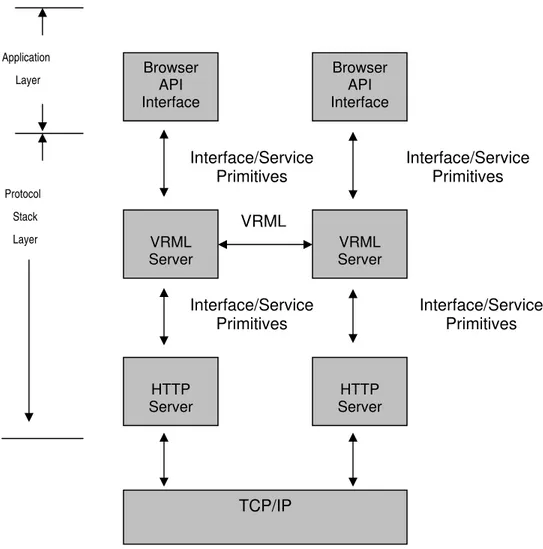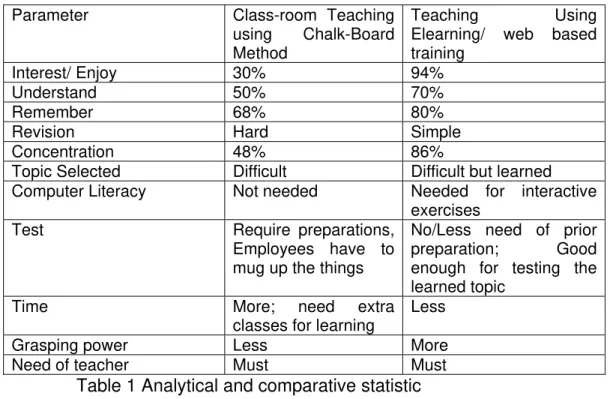Journal of Internet Banking and Commerce
An open access Internet journal (http://www.arraydev.com/commerce/jibc/)Journal of Internet Banking and Commerce, December 2007, vol. 12, no.3 (http://www.arraydev.com/commerce/jibc/)
Glimpses for Effective implementation of
Virtual Trainer
S.Arumuga perumal, Ph.D.
Reader and Head, Department of computer Science, S.T.Hindu College, Nagercoil-2
68, Mudaliar West New Street, Kottar, Nagercoil-629002, India
www.bhartfriends.com/aarumugam
visvnek@yahoo.co.in
Abstract
This paper discusses and suggests some ideas and necessary changes in implementation of virtual trainer in an organization. With the invention of new technologies like high speed computer networks and multimedia computers, there is an increasing awareness that direct face to face teaching is not the only possible mode of training methodology in an organization. There is a demand for preparing high quality multimedia training material across all faculties, which can be used by learners of the course who either cannot attend the live lectures or prefer to study in an off-line mode. Assignments, Seminars and evaluations are done though on line mode. A new trend in implementing virtual trainer in Muti-user Virutal Reality system is discussed in this paper. The awareness of computer-based training is analyzed with employees of different categories. This method also leads to the development of effective implementation of web based virtual trainer through out the world in the near future.
Keywords: Web based learning, collaboration, and agent-oriented framework, Animation
© S.Arumuga perumal, 2007
Introduction
E learning is a process of using multimedia technology and the Internet technology to improve the quality of learning in education. Multimedia technology allows the use of movie, audio and text resources to enrich the contents. Internet technology allows accessing the resources and services easily and effectively. E learning stimulates remote exchanges and collaboration. E learning empowers the learner in various situations in learning at schools, learning at university, learning at work and learning at home. E learning plays a fundamental role in developing web based training system for the implementation of Virtual trainer
Objective:
E-Learning help individuals to realize his or her full potential and lead a happy and fruitful life.
E Learning reduces the disparities and inequalities between individuals or groups.
E-Learning ensures that the skills available meet the needs of business and employer
E-Learning help to improve a new training era called E-training.
Uses
E learning is based on a reliable technology but is pedagogy oriented
E learning is a social process and should facilitate interaction and collaboration between people
Initiatives
As we move towards the knowledge society, excellent method of training system is well placed to take advantage of the revolution in virtual training.
By mobilizing and coordinating, the e learning initiative is playing an important role in helping the country to realize its potential to be the world leader in learning products and services.
E learning initiative helps coordinate community actions concerned with e-learning, as well as the economic and social players in the country.
E learning initiative is playing an important role for effective implementation of virtual university to produce high quality education through out the world in the near future.
Achievement plan
Fours levels of achievement plan
Infrastructure and equipment
Training at all levels
Quality contents and services
Cooperation and exchange of ideas
Implementing measures
Strategic studies covering schools, universities and links to cultural institutions
Working groups
Call for proposals for innovative projects
Consultation
Contact with all actors involved in e learning
Change in pedagogy through technology
New technology is changing our education and learning styles. The innovations and development brought by the new technologies in our information Technology era have started to appear in education. Virtual training has become a core training strategy around the world in recent years, with extending to a broad cross-section of knowledge sharing with in organization at different places through out the world.. Ready access to information and training lectures on the web, sharing concepts and suggestions across the Internet, joint lecturing across distant locations, create novel responsibilities for Employees and trainers and change the learning and training environment everlastingly. Many of the pedagogical changes have already occurred at the virtual trainer without much effort, seminars are taking advantage of on-line information; work plans may be submitted from home and discussed with the subject experts or with peers in an interactive distant mode.
Changes we need to implement Training program
agent-oriented framework; the agent-oriented framework introduces two different types of agents. One is a manager and other is a learner. The manager monitors the learning progress of group and promotes the discussion, if necessary, so as to reach their common goal successfully. The learners are assigned to individual participants and act as interaction mediators among participants. This program is fully a joint reaction of both the resource person and the program participants. They share their innovations and findings in broader scope through this Training program and improve the grasping power of the Employees.
Virtual Learning
All learners require a flexible approach to the course. In addition, communication between the learners and lectures was limited to face-to-face meetings during specified periods. In virtual classroom, content was used to help learners acquire the life-long learning skills vital for Employees on the brink of finding jobs in the IT industry. The learning skills are Information literacy skills, Research skills, communication skills, and presentation skills. In virtual environment, the examination-based assessment is being replaced by continuous assessment. This will motivate the learners continuously demonstrate competence by doing research and developing and presenting individually as well as collaboratively.
In web-based training s Employees and the resource persons are at a distance from each other. This means that the web based trainings lies on media. It has two constituent elements. One is presentation and the other is interaction. Presentation of learning matter is one-way traffic and the interaction between participants and the resource person’s participants is a two-way traffic. Both components should be concentrated on this training program
Components for Training program
The three main elements of this Program are
Course structure
CDROM materials
Web-based training support system.
The Course structure is prepared effectively so that it will coincide with the recent trends in their fields. The Course structure is innovative so that they can be motivated for research in their fields. The training material will improve the creativity of the new fields. So a well advanced planning is needed in developing course structure. Before preparing Course structure it must be discussed with subject experts for standards. Good courseware must give guidance to candidate but also provide a rich variety of background material when ever such is needed. The advent of digital libraries provides not only the most significant chances for computer based training ever but also the extensive background reservoir of material needed in many situations.
interest in further studying
Multi User Virtual Reality Systems:
The ultimate aim of VR systems is to transform the web from just a “publishing medium” into a new kind of place where people can work & play, learn & teach, buy or sell, gossip and govern and generally seek their fortune. This evolution can be summarized as below
PHASES PHASE 1 PHASE 2 PHASE 3
CONTEXT Institutional Personal Social
AUDIENCE Technical Professional Consumer
ARCHITECTURE Mainframe Desktop Networked
DISPLAY Text 2D Geometry
RAMANJI/Multi-user
ELEMENT Terminals Windows & Icon Scenes/ Avatars
Keeping in mind the “user control dynamics in the virtual environment”, the virtual environment itself can be classified into four broad categories.
SUSE (Single User Static Environment)
SUDE (Single User Dynamic Environment)
MUSE (Multi User Static Environment)
MUDE (Multi User Dynamic Environment)
A dynamic environment is so termed since it enables users of the environment to cause interesting behavior to happen. The dynamics of objects that are immutable by users is called “ static” the dynamics that are controlled by the users is called “dynamic” Examples of such “static” actions are “ A fountain that can not be turned on or off” by the user. The Figure 1 shows the construction of multi user VR systems on WWW by using the existing TCP/IP.
Applications of Multi user Virtual Environments
Virtual classroom
The days are not so far that you could attend the theory as well as the practical sessions with out moving single inch from your home but till have real experience of attending actual class rooms. Subjects can be analyzed on line and historical sights can be visited by attended a class on history
Virtual Touring
Application
Layer Browser API Interface
Browser API Interface
Interface/Service Primitives
Interface/Service Primitives Protocol
VRML
VRML Server VRML
Server Stack
Layer
Interface/Service Primitives
Interface/Service Primitives
HTTP Server
HTTP Server
TCP/IP
Figure 1 Multi user VR system
Analytical Studies
The Employees of an organization is divided into two groups.
With class room teaching only
With computer teaching (E learning environment).
In classroom teaching environment, topics were taught using chalk and board method, which is routinely used. In the e-Training environment. Teacher has taught the topics in both the groups using respective method. Employees were asked to provide report for their learning experience as well as data obtained by personal interview and were analyzed. The percentage values were calculated using following formula:
No. Of Employees feel positive in the group % Of response = --- x100
Total No. Of Employees in the group
Parameter Class-room Teaching using Chalk-Board
Method
Teaching Using Elearning/ web based
training
Interest/ Enjoy 30% 94%
Understand 50% 70% Remember 68% 80%
Revision Hard Simple
Concentration 48% 86%
Topic Selected Difficult Difficult but learned Computer Literacy Not needed Needed for interactive
exercises
Test Require preparations,
Employees have to mug up the things
No/Less need of prior preparation; Good enough for testing the learned topic
Time More; need extra
classes for learning
Less
Grasping power Less More
Need of teacher Must Must
Table 1 Analytical and comparative statistic
From the study, Employees can easily learn different topics with teacher using e learning/web based technology compared to traditional chalk and board method.
The implementation of the virtual university concepts are analyzed and discussed with different levels of environment through questionnaire and interviews and found their willingness for online training system. From the analysis
1. 82% of the people preferred online implementation for higher education and 18% of the people were not willing for online implementation
2. Under the category of educational qualification 43% of the people were
technically qualified and 39% of the people not technically qualified.
3. Under the category of sex, 44% of the people wee male and 38% of the people were female.
4. Under the category of age, 18% of the people were of the age above 30 years, 42% of the people were of the age group 21 to 30 years, 22% of the people were of the age below 20 years.
5. Under the category of computer knowledge people, 91% of the people had computer knowledge. Out of 91%, only 80 % are willing for Virtual University implementation.
6. 71% of the people like to implement both arts and science courses in online implementation.
7. 72% suggest international level standard syllabi, 18% suggest National level standard syllabi, and 10% prefer state level syllabi.
8. 58% of people suggest short-term courses initially, 14% suggested undergraduate level courses and 25% people suggested postgraduate level if very much effective for net-based training.
the world, Limitation of employees, No malpractices. Implementation of this program will motivate the learners for their higher training. This kind of learning process is adopted already in Tanjore Tamil Virtual University, which is not highly attracted by the environments yet.
References
Dweeck. Carol. S “Motivational process affecting learning” American Psychologist 40 (10); pp 1040-1048, 1986
Edwards,J. ”Redefining IT career paths for the New Millennium “, IEEE computer, January 2000,16-20
Tomoko Kojiri, Yushi Ogawa,Toyohide Watanabe, “Agent-Oriented Support Environment in Web-Based Collaborative Learning”, JUCS, Volume 7, Issue 3
Tsichritzis.D, “Reengineering the university”, Communications of ACM communications, June 1999,vol 42, No 6

